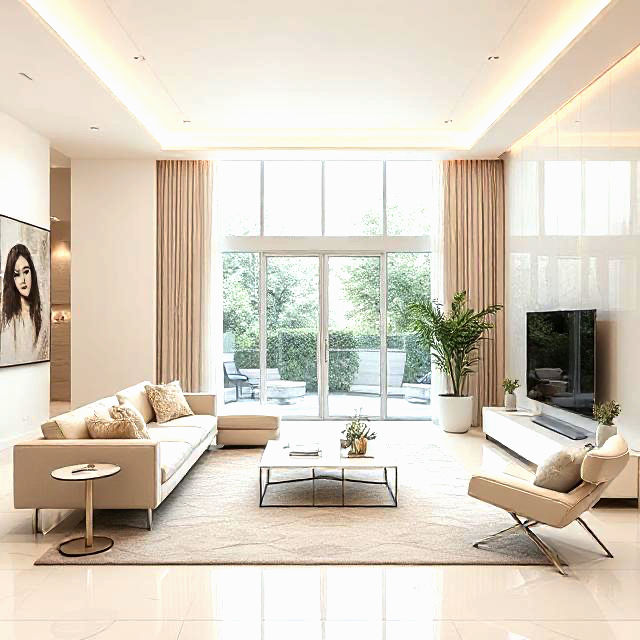Interior Design Trends 2025: What’s In, What’s Out, and Why It Matters
- ARDENT-SPACE

- Aug 14
- 3 min read
Updated: Sep 18
Whether you’re a seasoned interior designer crafting spaces for tomorrow or a style enthusiast chasing the next “it” look, interior trends in 2025 offer both inspiration and opportunity. Some follow trends religiously, finding confidence in being perfectly on-point; others adapt selectively, blending what’s current with their existing aesthetic; and a growing number have forged a timeless personal style that transcends seasonal shifts. The current design landscape speaks to all three – merging sustainability, individuality, and emotional connection – so whether you live by the trend report, cherry-pick the best bits, or proudly chart your own course, knowing what’s in, what’s out, and why it’s changing, will keep you ahead of the curve.
What’s In
Sustainable & Circular Design – Using reclaimed, recycled, and responsibly sourced materials; furniture that’s built to last.
Biophilic & Nature-Inspired Design – Embracing raw, organic materials – reclaimed wood, rattan, travertine – with abundant greenery and daylight. These foster relaxation, improve air quality, and evoke connection to nature.
Warm Minimalism – Clean lines softened with cozy textiles, earthy tones, and lived-in charm.
Statement Lighting – Sculptural, bold lighting pieces that double as art.
Personalized Spaces – Décor that reflects the homeowner’s personality rather than just following a catalogue look.
Tactility & Textural Layering – Tactile wall coverings, sculptural pieces, and texture-rich materials to create richly layered environments with sensory appeal.
Multifunctional Spaces & Smart Integration – Adaptive layouts and hidden functionality (fold-away desks, modular furniture) meet seamless smart home integration like voice-controlled lighting or automated climate control.
Warm Earth Tones & Rich Color – Moving away from cool grays, 2025 favors terracotta, sage, chocolate brown, ochre, and burgundy – creating depth, comfort, and emotional resonance.
Art Deco, Maximalism & Nostalgic Revival – Expect richly patterned textiles, curved furniture forms, and vintage inspirations from the 1920s–‘30s, with maximalist layering for personality and nostalgia.
What’s Out
All-White Sterile Interiors: Now seen as cold and impersonal; the shift is toward warmth and individuality.
Fast Furniture & Cheap Decor: There’s a growing preference for quality, sustainable, and long-lasting pieces over disposable or mass-produced options.
Industrial Aesthetics & Hyper-Minimalism: Stark metals, pipes, and overly minimal environments are falling out in favor of cozy textures and character.
Hyper Matching Furniture Sets: Uniformity is out; eclectic and layered mixes that reflect personality are now on trend.
Overconsumption of Décor – Filling spaces with excess accessories just for the sake of abundance.
Trendy for Trend’s Sake – Blindly following social media aesthetics without considering long-term livability.
Summary Table – Why It Matters
2025 Trend Direction | Why It Matters |
Sustainable & Circular Design | Reduces waste, supports eco-conscious living |
Biophilic Elements | Improves well-being, reduces stress |
Warm Minimalism | Balances simplicity with comfort |
Statement Lighting | Acts as both functional and artistic element |
Personalized Spaces | Builds emotional connection and longevity |
Sensory-Rich Environments | Feels dynamic, layered, and engaging. |
Functionality & Adaptability | Flexible lifestyles with evolving spaces |
Phasing Out Fast Furniture | Encourages durability and craftsmanship |
Moving Away from Sterile Palettes | Creates warmth and liveability |
After years of staying more indoors due to the pandemic, people want homes that feel restorative, healthy, and personal. Many are investing in fewer but better-quality pieces. Social media still drives aesthetics, but with an increasing push toward showing authentic living rather than just staged perfection. Younger generations embrace eclecticism, blending vintage with modern to create unique narratives.
The overarching shift is from clean, impersonal minimalism toward warmth, sustainability, and expression – spaces designed not just to be seen, but felt.
Summary: What's In vs. What's Out
In | Out |
Biophilic elements, greenery, earthy tones | Sterile, monochrome, minimalist spaces |
Bold, joyful color palettes (“Dopamine Decor”) | Muted neutrals, bland minimalism |
Textural layering & sculptural details | Flat surfaces, industrial coldness |
Adaptive, multifunctional layouts | Rigid, single-use interiors |
Sustainable materials & vintage/unique finds | Fast furniture & disposable trends |
Closing
As trends cycle faster and consumer awareness deepens, the question isn’t whether you should follow them, but how. For the devoted trendsetters, 2025 offers a fresh palette of ideas to master and showcase. For the selective adapters, our easy integration guidelines make it simple to weave in new looks without overhauling your space. And for the timeless stylists, these shifts can be read not as directives, but as a cultural pulse – signals to be interpreted, not obeyed. For a deeper dive into balancing inspiration with individuality, see our companion article on why avoiding design trends can be the boldest style move of all. However you position yourself, the key to great design – now more than ever – is making your space tell your story.





Comments